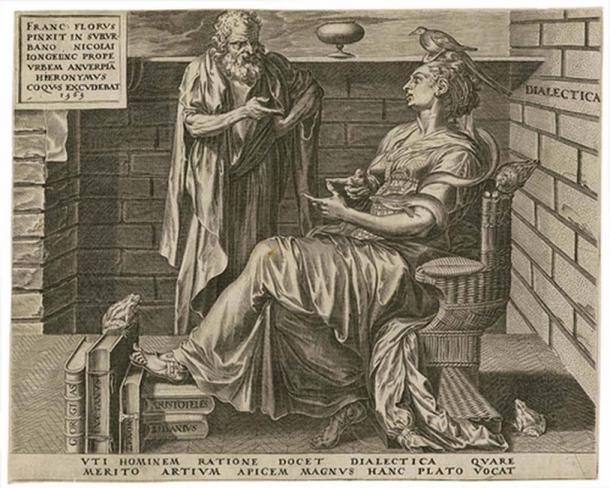Apeiron, The Source of All Things and The Philosophies of Anaximenes
Anaximenes was a Pre-Socratic philosopher who belonged to the Milesian school. According to tradition, Anaximenes was a student and associate of Anaximander of Miletus. Alternatively, Anaximenes is said to have been an associate of Anaximander.
The philosopher Porphyry of Tyre, quoting a Samian poet, claims that Pythagoras of Samos had also studied under Anaximander. Whether or not this is true, Pythagoras went on to found his own school of philosophy. Anaximenes, on the other hand, carried on the legacy of the Milesian school, and is today remembered, along with Anaximander and Thales, as one of the three prominent figures of this school.

Anaximander of Miletus. (Public Domain)
Whilst little is known about the life of Anaximander, even less is known about that of his student, Anaximenes. We do know that Anaximenes was from Miletus, and that his father, according to the ancient writer Laertius Diogenes, was a man by the name of Eurystratus. His date of birth is not known to have been preserved in the written sources, and it is commonly speculated that he was born around 585 BC. Diogenes does provide, however, a rough date for Anaximenes’ death,
“And he lived, according to the statements of Apollodorus, in the sixty-third Olympiad, and died about the time of the taking of Sardis.”
This has been interpreted to mean that Anaximenes died around 528 BC.
- Disbelieve it or Not, Ancient History Suggests That Atheism is as Natural to Humans as Religion
- Armillary Spheres: Following Celestial Objects in the Ancient World
Defining His Archê
For many, the philosophical ideas that he expounded are more important than the details of Anaximenes’ life. Like the other philosophers of the Milesian school, i.e. Thales and Anaximander, Anaximenes was also interested in finding out the archê, or the common substance that all objects in the world are composed of. For Thales, this was water, whilst for Anaximander, it was apeiron. Although Anaximenes did not agree entirely with Anaximander’s concept of the apeiron (whilst Anaximenes agreed that the nature of the archê should be unlimited, he did not agree that it was indeterminate), he disagreed with Thales’ idea as well. Nevertheless, it may be said that Anaximander’s idea of the archê is closer to that of Thales’ than that of Anaximander’s.

Illustration from "Illustrerad verldshistoria utgifven av E. Wallis. Volume I": Thales.
Instead of speculating on a theoretical element like Anaximander’s apeiron, Anaximenes, like Thales, chose a known element to be his archê. It was air that Anaximenes proposed as the archê, a strange choice, perhaps, if one does not know the reasoning behind it.
Anaximenes believed that air could take on different appearances, and even transform into different substances via the process of rarefaction and condensation. When air is rarefied, so claimed Anaximenes, it would become fire. On the other hand, when air is condensed, it would become wind, then cloud, water, earth, and finally stone.
The process of rarefaction and condensation, as well as the supposed transformative nature of air serves to answer one of Anaximander’s criticisms of Thales. According to Anaximander, it is impossible for any known element to be the archê, as none of them possess all the opposites found in nature. In other words, with Anaximenes’ philosophical idea in mind, one may ask “If air is the archê, why doesn’t everything have the properties of air?” For Anaximenes, the answer is straightforward: rarefaction and condensation simply means that in any region, air is present, though its density is either less or more.

Illustration of Anaximenes. (escuelapedia)
A Different Structure of the Cosmos
Another aspect which Anaximenes disagreed with Anaximander is the structure of the cosmos. Like his teacher, Anaximander agreed that the world is flat. As to the reason for the earth’s stability, Anaximenes proposed that it is supported by, and rests on a column of air. Somehow, this column of air is stationary, thus preventing the earth from falling.
Yet, oddly enough, Anaximenes suggests that the movement of the other celestial bodies is accounted for by the constant movement of air. Implicitly, this would mean that air surrounds the earth on all sides. This makes Anaximander’s theory difficult to make sense, as no explanation is given as to why the column of air supporting the earth from below is stationary in the first place.
- Darwin Theory
- Unearthing the Ancient Port of Naukratis, a Bridge between Egyptian and Greek Civilization
It has been said that Anaximenes, as a thinker, was less adventurous than Anaximander. Some have even claimed that his proposition that air is the archê constitutes a step backwards for philosophy.
Nevertheless, it has been pointed out that it was Anaximenes’ theories, rather than those of Anaximander, that the later Pre-Socratics would consider when forming their views on astronomy and meteorology. For instance, Anaximenes’ theory regarding the transformation of matter through rarefaction and condensation would be further developed by Heraclitus, and criticized by Parmenides.
Featured image: Anaxímenes de Mileto. Photo Credit: Hartmann Schedel (1440-1514). Liber Chronicarum. Koberger, Anton imp. 1493. Xilografía. Nuremberg.
By Wu Mingren
References
Diogenes Laertius, The Lives and Opinions of Eminent Philosophers: Life of Anaximenes [Online]
[Yonge, C. D. (trans.), 1853. Diogenes Laertius’ The Lives and Opinions of Eminent Philosophers: Life of Anaximenes.]
Available at: http://www.classicpersuasion.org/pw/diogenes/dlanaximenes.htm
Graham, D. W., 2016. Anaximenes (d. 528 B.C.E.). [Online]
Available at: http://www.iep.utm.edu/anaximen/#H4
Mastin, L., 2008. Anaximenes. [Online]
Available at: http://www.philosophybasics.com/philosophers_anaximenes.html
McKirahan, R. D., 2010. Philosophy Before Socrates. 2nd ed. Indianapolis: Hackett Publishing Company, Inc..
Porphyry, The Life of Pythagoras [Online]
[Guthrie, K. S. (trans.), 1920. Porphyry’s The Life of Pythagoras.]
Available at: http://www.tertullian.org/fathers/porphyry_life_of_pythagoras_02_text.htm
Stamatellos, G., 2006. Anaximenes of Miletus. [Online]
Available at: http://www.philosophy.gr/presocratics/anaximenes.htm

















